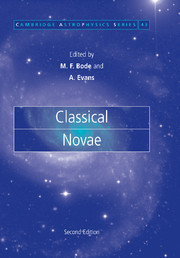Book contents
- Frontmatter
- Contents
- List of contributors
- Preface to the first edition
- Preface to the second edition
- List of symbols
- 1 Novae: an historical perspective
- 2 Properties of novae: an overview
- 3 The evolution of nova-producing binary stars
- 4 Thermonuclear processes
- 5 Nova atmospheres and winds
- 6 Observational mysteries and theoretical challenges for abundance studies
- 7 Radio emission from novae
- 8 Infrared studies of classical novae
- 9 Optical and ultraviolet evolution
- 10 X-ray emission from classical novae in outburst
- 11 Gamma-rays from classical novae
- 12 Resolved nebular remnants
- 13 Dust and molecules in nova environments
- 14 Extragalactic novae
- Object index
- Subject index
5 - Nova atmospheres and winds
Published online by Cambridge University Press: 10 October 2009
- Frontmatter
- Contents
- List of contributors
- Preface to the first edition
- Preface to the second edition
- List of symbols
- 1 Novae: an historical perspective
- 2 Properties of novae: an overview
- 3 The evolution of nova-producing binary stars
- 4 Thermonuclear processes
- 5 Nova atmospheres and winds
- 6 Observational mysteries and theoretical challenges for abundance studies
- 7 Radio emission from novae
- 8 Infrared studies of classical novae
- 9 Optical and ultraviolet evolution
- 10 X-ray emission from classical novae in outburst
- 11 Gamma-rays from classical novae
- 12 Resolved nebular remnants
- 13 Dust and molecules in nova environments
- 14 Extragalactic novae
- Object index
- Subject index
Summary
Introduction
The modeling and analysis of early nova spectra have made significant progress since the first edition of this book. The main culprit is the author, via the construction of detailed model atmospheres and synthetic spectra for novae (Hauschildt et al., 1992, 1994a,b, 1995, 1996, 1997; Pistinner et al., 1995; Schwarz et al., 1997; Short et al., 1999; Schwarz et al., 2001; Short et al., 2001; Shore et al., 2003).
In the early stages of the nova outburst, the spectrum is formed in an optically very thick (in both lines and continua) shell with a flat density profile, leading to very extended continuum and line-forming regions (hereafter, CFR and LFR respectively). The large variation of the physical conditions inside the spectrum-forming region makes the classical term ‘photosphere’ not very useful for novae. The large geometrical extension leads to a very large electron temperature gradient within the CFR and LFR, allowing for the observed simultaneous presence of several ionization stages of many elements. Typically, the relative geometrical extension Rout/Rin of a nova atmosphere is ∼ 100–1000, which is much larger than the geometrical extension of hydrostatic stellar atmospheres (even in giants Rout/Rin is typically less than 2) or supernovae (SNe).
The electron temperatures and gas pressures typically found in nova photospheres lead to the presence of a large number of spectral lines, predominantly Fe-group elements, in the LFR and a corresponding influence of line blanketing on the emergent spectrum.
- Type
- Chapter
- Information
- Classical Novae , pp. 102 - 120Publisher: Cambridge University PressPrint publication year: 2008
- 5
- Cited by



